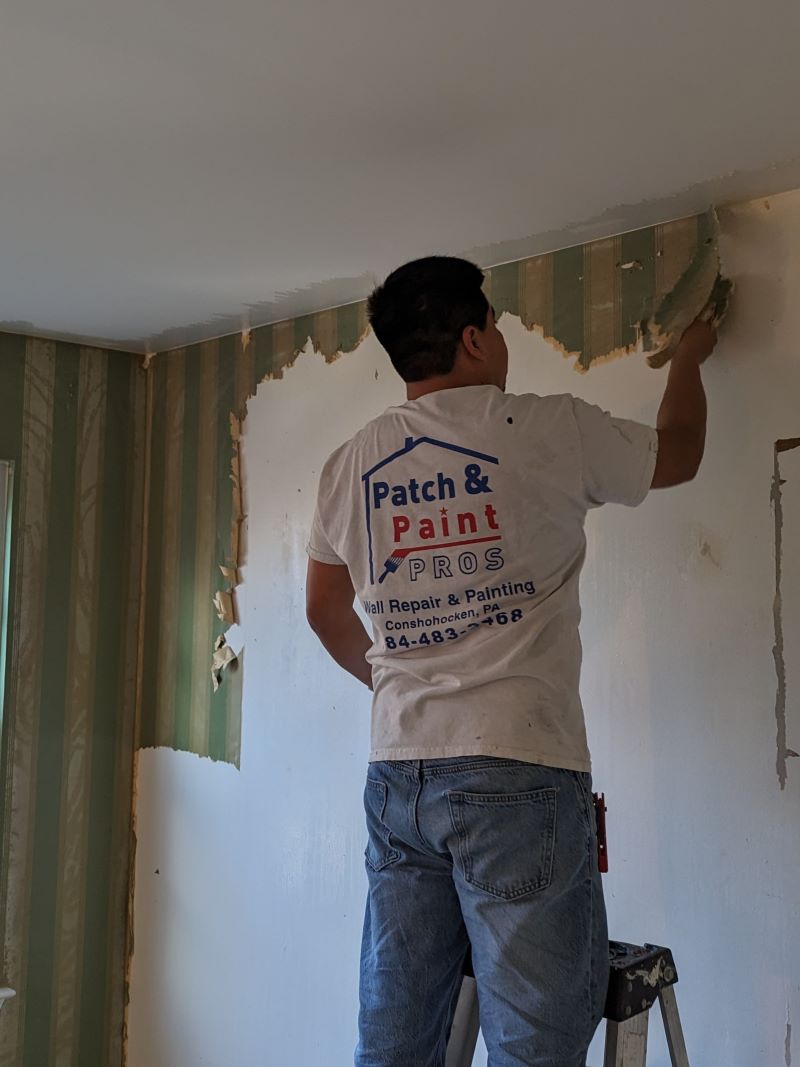House painting is not something that you can do casually. It requires effort, skill, and knowledge to ensure that your interior walls look perfect. Fortunately, professional interior house painters are experienced in the process and are equipped with the right tools and materials to ensure that the task is done efficiently.
At Patch and Paint Pros painting company in Conshohocken, PA, we have helped 100’s of local homeowners experience a seamless painting project. If you’re located in nearby Montgomery, Chester or Delaware counties, please give us a call (or text) to learn more information
When it comes to house painting, choosing the right house painter is essential. A house painter should have a good reputation, be reliable and trustworthy, and provide quality service at an affordable cost. In this article, we will discuss eight tips from professional internal house painters to help you paint your walls like a pro.
As interior house painters, we can’t stress enough the importance of keeping safety in mind when taking on any painting project. Wear the appropriate protective gear such as long sleeve shirts, long pants, gloves, and eyewear when dealing with any potentially hazardous materials. Additionally, make sure to properly ventilate any newly painted indoor areas to prevent exposure to any lingering fumes or solvents. By taking these precautions, you can remain safe and enjoy your new interior space!
When it comes to accent wall painting or any other painting project, it is important to take into consideration what type of paint should be used. Internal house painters often suggest using latex paints for walls and ceilings, while oil-based paints are recommended for accent walls, doors, and trim work to achieve the best results.
Painting is one of the most enjoyable methods of redecorating a home, and designer paints can help transform an ordinary room into a masterpiece. When choosing paint for an accent wall, designer options are ideal for their superior performance and longer-lasting protection from wear and tear.
Designer paints are available in many finishes, allowing you to select the perfect shade and texture to add just the right splash of color to your home. Whether you’re aiming for subtle luxury or stunningly bold style in your accent wall, designer paints will provide beautiful results with extended longevity.
Oil-based paint is one of the oldest forms of paint and is best used in areas that require superior coverage, such as trim and doors. Oil-based paints take longer to dry than other types, but they are more durable and provide better protection against water damage. However, they also have an unpleasant smell and are more difficult to clean up than other types of paints.
Latex paint is a synthetic acrylic polymer based on water that has been around since the 1950s. It is used primarily for interior walls and ceilings because it offers better coverage than oil-based paints and is easier to clean up; however, it does not offer as much protection from water damage as oil-based paints do. Latex paints also come in a variety of finishes, including flat, low-sheen, eggshell, satin, semi-gloss, and high gloss.
Waterborne alkyd paint combines the durability of an oil-based paint with the easy cleanup of latex paint. It offers excellent coverage and does not require a primer before application. It is an ideal choice for kitchen cabinets or trims because it dries quickly and provides superior protection against water damage without having an unpleasant smell like oil-based paints do. Waterborne alkyd paints come in a variety of finishes including satin and semi-gloss.
If you’re located in nearby Montgomery, Chester or Delaware counties in Pennsylvania, give us a call to learn more about experiencing a seamless painting project
Preparing the surface for painting is an integral part of achieving a successful, long-lasting paint job. Preparing the surfaces properly will lead to better paint adhesion and longer color retention. Professional house painters typically advise applying a primer to lock in any contaminants that may cause bubbling or peeling. They also suggest sanding and scraping any uneven surfaces or cracks you may find, taking care to pay attention to corners and crevices as these areas require additional prep work.
Make sure you have all the materials needed ready beforehand, such as putty knives, scrapers, sandpaper, brushes, and rollers for cleaning and painting tasks. Gather these materials before beginning the prep work to ensure a smooth workflow and high-quality results when your painting adventures commence.
Using the right tools is key to a successful paint job. Having the proper tools can repair work much easier and quicker, saving time and money. Professional house painters typically use a roller, brush, and sprayer when applying paint for an even finish. A paint shield helps catch any over-spray that could potentially damage surrounding areas of the wall or ceiling. Investing in quality tools will guarantee a successful paint job – resulting in repair costs down the line being lesser.
If you plan on using a brush to paint your walls, it’s important to choose one with the right type of bristles. The bristles should be soft enough so as not to leave brush marks in the paint but firm enough so that the brush won’t lose its shape during use. A good quality roller is also essential for painting large areas quickly and evenly. When choosing a roller, consider the size of your walls and pick the appropriate width and length accordingly.
Using painter’s tape is essential if you want crisp lines around your windows or doors, trim, or other features. Painter tape is designed to stick firmly but not damage the surface of your walls when removed. Make sure to press down firmly on all edges of the tape and wait at least 20 minutes before beginning to paint over it, this will ensure that it sticks properly and prevents any paint from seeping underneath it while you work.
Protecting your floors, furniture, and countertops with drop cloths is key when doing any kind of painting project inside your home. Not only will this help contain messes while working but it will also protect surfaces from spills or splatters once the project is complete.
It’s also important to wear proper protective gear such as safety glasses or goggles and an appropriate respirator mask if needed for particular types of paints or finishes used in your project.
You want to start your project with a clean slate, so it’s important to scrape off any old paint before applying fresh coats. Investing in a good scraper or putty knife can make all the difference here—look for options that are well-constructed and comfortable in your hand as these will help ensure smooth application without any hiccups.

Working with paint is a creative and enjoyable experience, especially when it comes to house painting. With paint, professional internal house painters can create unique looks and finishes that can transform any interior space. Today’s paint colors are more vibrant than ever before and there is so much that can be achieved with different color combinations, textures, and finishes.
Instead of settling for the same old paint job, it’s possible to experiment with paint on wall space to come up with something custom. Professional painters have the knowledge, skills, and experience necessary to make these combinations come together to satisfy a customer’s expectations. With the right paint job, interior space can become a true masterpiece.
When deciding on the ideal color scheme for a space, professional house painters always suggest considering the ceiling height, wall height, and available natural and artificial light sources. Lighting can be used to craft an atmosphere that you desire- such as a warm and cozy feeling or a bright and modern feel.
Different types of lighting can produce different shadows and hues on painted surfaces – so play around with textures and colors to find the right balance. Lighting is often overlooked when painting a room, but it is something that should be taken into consideration as it plays an important role in creating the finished look.
Interior painters will agree – the key to achieving a flawless finish is taking your time. Many DIY-ers fall into the trap of rushing, trying to get the job done as quickly as possible. But what’s often overlooked is that every little detail is hugely important – from careful application of paint to furnishing protection, and making sure each wall looks perfect.
So if you’re looking for professional-looking results, slow down and take the time needed to ensure each step is handled with precision. A rushed interior painting job looks sloppy in comparison to one taken on with patience and care.
After you’re finished with a house interior painting job, it’s important to treat the house like a masterpiece. Professional house painters suggest using a vacuum and damp cloth to get rid of any dust or debris, as well as wiping down walls and windows to restore their brightness. Cleaning up after a project is the essential final step for successful painting contractors. There’s no need to rush through the cleaning process though – taking your time here will make sure you leave the house with beautiful walls that are clean enough for its next chapter.
Painting walls is a tricky job and is best left to experienced professional house painters. However, with the right knowledge and techniques, you can turn your interior décor into something truly amazing. We hope that the eight tips discussed in this article have helped point you in the right direction for your next interior painting job.
After you’re finished with a house interior painting job, it’s important to treat the house like a masterpiece. Professional house painters suggest using a vacuum and damp cloth to get rid of any dust or debris, as well as wiping down walls and windows to restore their brightness. Cleaning up after a project is the essential final step for successful painting contractors.
There’s no need to rush through the cleaning process though – taking your time here will make sure you leave the house with beautiful walls that are clean enough for its next chapter. After you’re finished with a house interior painting job, it’s important to treat the house like a masterpiece.
Professional house painters suggest using a vacuum and damp cloth to get rid of any dust or debris, as well as wiping down walls and windows to restore their brightness. Cleaning up after a project is the essential final step for successful painting contractors. There’s no need to rush through the cleaning process though – taking your time here will make sure you leave the house with beautiful walls that are clean enough for its next chapter.

Contact
Awards & Accolades
Our Service Area
We take pride in providing top rated painting and drywall services to local home owners and businesses. Our service area includes nearby Chester, Montgomery and Delaware Counties.
